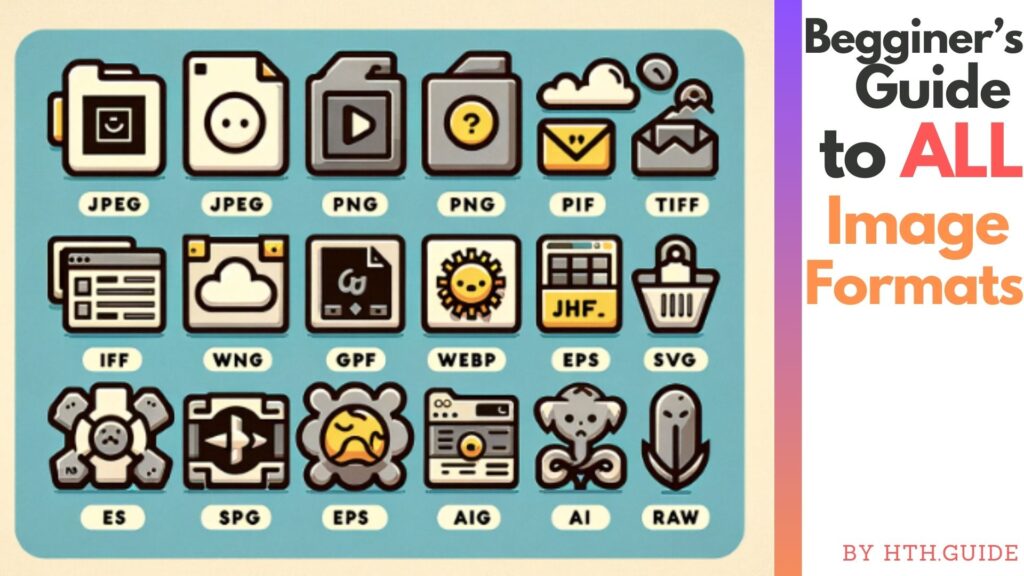On This Page: [hide]
What Are Image File Formats and Why Are They Important?
Image file formats are the ways images are stored on digital devices. They influence the image’s quality, size, and compatibility with different software and devices. Choosing the right format ensures your images look their best and load quickly on websites. Different formats are suited for various uses, such as web graphics, printing, or simple storage.

Image File Formats
JPEG: Best Practices and Common Uses
JPEG (Joint Photographic Experts Group) is widely used for photographs and web images. It uses lossy compression, which reduces file size by removing some image data. This makes JPEG ideal for images with lots of colors and details but not for those needing high precision.
PNG: Ideal for Web Graphics and Transparency
PNG (Portable Network Graphics) is perfect for web graphics, logos, and images that require transparency. It uses lossless compression, which maintains the image quality while reducing file size. PNG supports millions of colors and preserves image details, making it a good choice for detailed images.
GIF: When to Use Animated Images
GIF (Graphics Interchange Format) is used for simple animations and images with limited colors. It supports up to 256 colors and can include transparency. GIF is great for small animations and simple graphics on websites.
TIFF: High-Quality Types for Printing
TIFF (Tagged Image File Format) is used for high-quality images and professional printing. It supports multiple layers and lossless compression, preserving all image details. TIFF files are large, making them unsuitable for web use but ideal for print.
BMP: Benefits and Drawbacks
According to sources, like MDN Web Docs, BMP (Bitmap) files are uncompressed and very large. They maintain high image quality but are not practical for web use due to their size. BMP is mostly used for storing high-quality images without any compression artifacts.
WebP: Advanced Compression for the Web
WebP is a modern image format that offers superior compression for web images. It supports both lossy and lossless compression, transparency, and animations. WebP files are smaller and load faster, making them ideal for websites.
Vector vs. Raster: Which is Better Image File Format?
Understanding Vector Image File Formats (SVG, EPS, AI)
Vector images are created using mathematical formulas, allowing them to be resized without losing quality. Formats like SVG, EPS, and AI are ideal for logos, icons, and illustrations that need to be resized frequently.
The Advantages of Raster Images for Photos
Raster images are made up of pixels and are best for photographs and images with complex color variations. Formats like JPEG, PNG, and TIFF fall into this category and are excellent for detailed, high-resolution images.
How to Choose the Right Image Resolution
High-Resolution vs. Low-Resolution Images
High-resolution images have more pixels, offering better quality but larger file sizes. Low-resolution images load faster but can appear blurry if scaled up. Choose the resolution based on whether the image is for print or web use.
Selecting the Right Resolution for Your Needs
For print, use high-resolution images (300 DPI or more). For web use, 72 DPI is usually sufficient, balancing quality and load speed.
Optimize Images for the Web
Compress Images Without Losing Quality
Use tools like TinyPNG or ImageOptim to compress images while preserving quality. Compression reduces file size, improving website load times and performance.
Tools for Image Optimization
Popular tools for image optimization include Adobe Photoshop, GIMP, and online services like Kraken.io and Compressor.io. These tools help you balance image quality and file size.
Implement Lazy Loading to Improve Load Times
Lazy loading defers the loading of off-screen images until the user scrolls to them, enhancing page load speed and user experience and reducing errors.
Select the Best Image Format for Your Project
Websites and Blogs: Best Practices
Use JPEG for photos, PNG for graphics and images with transparency, and WebP for a balance of quality and file size. Ensure images are optimized for fast loading.
Social Media Graphics: What Works Best
PNG and JPEG are widely supported on social media platforms. PNG is ideal for images with text or transparency, while JPEG is suitable for photos.
Professional Printing: Formats to Use
TIFF and PDF are preferred for printing due to their high quality and support for detailed images and text.
Email Marketing: Choosing the Right Format
JPEG is ideal for email marketing due to its small file size and good quality. Ensure images are optimized to avoid slow load times.
Edit and Convert Image Files Effectively
Top Software for Image Editing
Use Adobe Photoshop, GIMP, or Affinity Photo for advanced editing. These programs offer powerful tools for enhancing and modifying images.
Step-by-Step Guide to Converting Image Files
- Open the image file in your editing software.
- Select ‘Save As’ or ‘Export’ from the menu.
- Choose the desired format from the list.
- Adjust the quality and compression settings as needed.
- Save the file to your desired location.
Advanced Image File Formats to Consider
HEIF and HEIC: High Efficiency Options
HEIF and HEIC offer superior compression and quality for images and videos. These image file formats are ideal for saving storage space without compromising image quality.
Exploring JPEG2000 and JPEG XR
JPEG2000 and JPEG XR provide better compression and quality than standard JPEG. They support higher bit depths and lossless compression, making them suitable for professional use.
RAW Files: What Photographers Need to Know
RAW files contain unprocessed image data, offering maximum flexibility for editing. They are essential for professional photographers who need the highest quality.
Image File Formats for Specific Use Cases
Digital Artwork and Illustrations
Use vector formats like SVG and AI for artwork and illustrations. These formats ensure scalability and maintain quality at any size.
Infographics and Data Visualization
SVG is ideal for infographics and data visualizations due to its scalability and sharpness. PNG is a good alternative for raster-based graphics.
E-commerce Product Images
JPEG and WebP are excellent for e-commerce product images, balancing quality and file size. Ensure images are optimized for fast loading and high quality.
